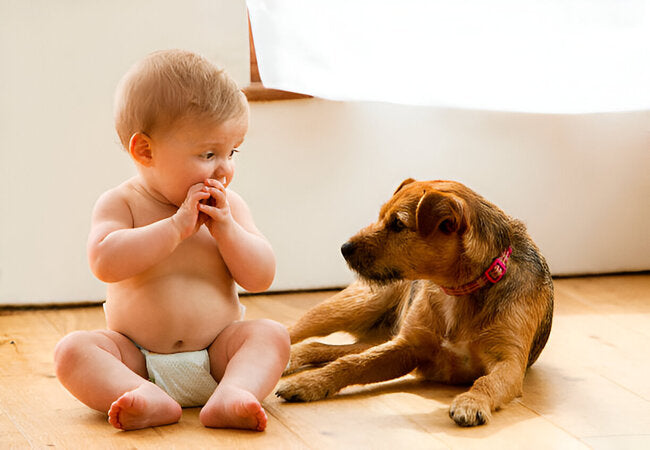Vet‑Approved 2025: Safely Introducing Babies to Pets – A Vet’s Guide to Harmony 🍼🐾

In this article
Vet‑Approved 2025: Safely Introducing Babies to Pets – A Vet’s Guide to Harmony 🍼🐾
By Dr. Duncan Houston BVSc
Welcoming a new baby into a household with pets is a beautiful milestone, but it also introduces new dynamics, stressors, and safety considerations. In 2025, veterinarians agree: thoughtful preparation, calm introductions, clear boundaries, and ongoing supervision are essential to foster harmony and safety. This comprehensive, vet‑approved guide will help pets and babies thrive together—from prenatal prep to toddler milestones. Let’s create a peaceful, connected home for all! 🐶👶🐱✨
1. 🕒 Begin Pre‑Arrival Preparation
1.1 Gradual scent introductions
Introduce your pet to baby-related scents weeks before arrival—blankets, lotions, wipes. Studies show pets form positive associations earlier this way. Bring home a hospital blanket post‑birth and allow your pet to sniff it before the actual baby arrives.
1.2 Acclimate to baby sounds & gear
Play recordings of baby crying, laughing, or cooing at low volume during feeding/playtime, gradually increasing volume as your pet stays calm. Introduce stroller, carrier, swing—walk the dog using the stroller to create positive associations.
1.3 Adjust routines gradually
Baby’s arrival will disrupt routines. Begin shifting feeding, walking, and playtimes in advance so pets adjust more smoothly. Ensure they still receive individual attention—even a 5‑10 minute cuddle or training sessions reduce stress.
2. 🏠 Prepare the Home Environment
2.1 Create safe spaces for pets
Set up pet-only zones—crates, rooms, gated areas—where they can retreat without baby intrusions. Feed, play, and rest here to build positive associations.
2.2 Nursery boundaries
Use baby gates or closed doors to keep pets out of baby-only zones. Cats, especially, should not have access to cribs or bassinets—sharp claws pose a risk.
3. 🤝 The First “Sniff‑Down” Introduction
3.1 Stay calm—don’t lead with emotions
Enter home without the baby first—this lets your pet greet you calmly. Tension or excitement can translate to the pet.
3.2 Leashed, quiet introductions
After they’ve calmed, bring in baby in arms or a carrier. Keep the dog on a leash and allow them to sniff from a distance. Avoid hugging the baby tightly in the presence of a pet—the pet should approach, not be forced.
3.3 Treat-based association
Drop treats near the baby (away from both) and reward calm behavior. Reinforce pets slowly exploring the baby’s scent as a good thing.
3.4 Observe body language carefully
Monitor for stress (lip licking, yawning, avoidance) or tension (stiff posture, staring). Immediately redirect and provide distance if they show signs of discomfort.
4. 🔄 Ongoing Supervision & Integration
4.1 Never leave unattended
Even well-behaved pets can react unexpectedly, especially to sudden baby movements. Always supervise first-year students.
4.2 Maintain positive attention
Continue giving pets one-on-one attention daily. Short walks or play sessions help pets stay balanced and prevent jealousy.
4.3 Support understanding boundaries
Train commands like “go to mat,” “sit,” and “leave it.” Use them consistently to manage comfort and structure during baby interactions.
5. 🧒 Teaching Children Safe Interactions
5.1 Gentle petting training
Teach toddlers to offer open palms, pet away from faces, and never pull ears or tails. Role-model proper behavior and correct missteps gently.
5.2 Respect pet spaces
Show children signs of pet discomfort—like hiding or stiff body language—and teach them to leave the pet alone during these times.
6. 🛠 Dealing with Challenges
6.1 Fearful or aggressive responses
If pets growl, snap, or withdraw, consult a veterinary behaviorist. They may need structured desensitization or behavior shaping with low reward plus distance.
6.2 Cat-specific concerns
Keep nails trimmed, and train cats with a harness/leash for calm supervised visits. Provide vertical spaces where they can escape quietly.
7. 🎉 Reinforcing a Cohesive Family
- Celebrate calm, positive pet-baby interactions with treats or affectionate praise. Encourage pets to associate baby presence with good things.
- As the baby grows, encourage safe exploration—reading pet body language and allowing pets to set the interaction pace.
- Reassess routines and boundaries as the baby becomes mobile—update safe zones, gates, and supervision levels accordingly.
📱 Ask A Vet App 2025 Support
- 📹 Video reviews: Share your pet-baby introduction clips for expert insight on timing, tone, cues, and stress signals.
- 🧩 Customized integration plans: Receive step-by-step guidance tailored to your pet’s personality and your baby’s age.
- 💬 Live coaching: Real-time support during milestone introductions—first baby steps around pets, toddler-pet playtime, and more.
❤️ Final Thoughts
Introducing babies to pets is more than a cute photo opportunity—it’s a crucial step that shapes a peaceful family dynamic for years. In 2025, vet-approved methods emphasize slow scent/sound exposure, calm first meetings, structured routines, and active supervision. With preparation, patience, and positive reinforcement, you can build trust, safety, and love between your new baby and furry family members. 🍼🐾
Interested in printable introduction checklists, stress-signal posters, or toddler-pet play guides? Visit AskAVet.com or download the Ask A Vet app for video review, expert plans, and real-time coaching—so your family bond grows safely and joyfully! 🌟






